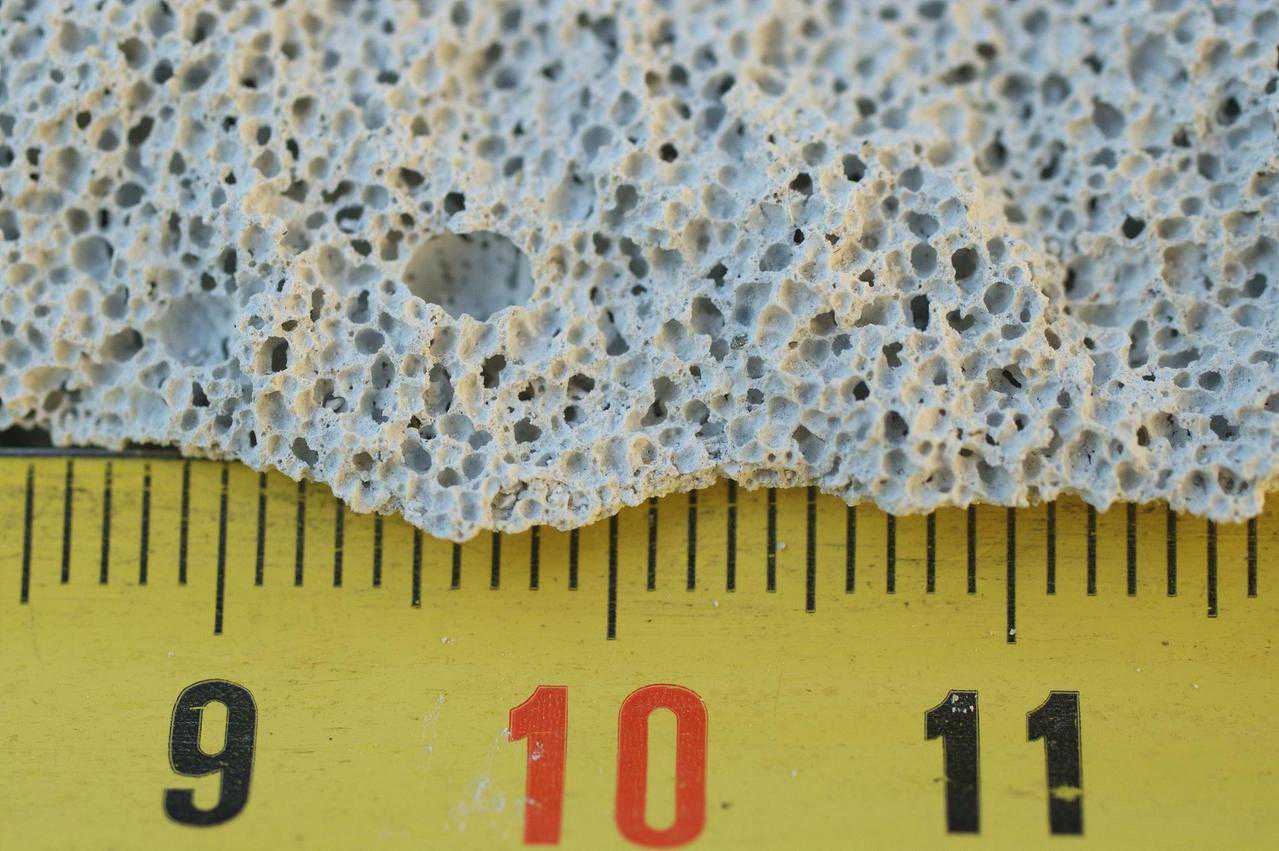
An unclose view of aerated concrete with the air bubbles visible. (Marco Bernardini – Own work, CC BY-SA 3.0)
Aerated concrete vs. thin-shell concrete
Aerated concrete is conventional concrete infused with air bubbles or styrofoam beads to make the concrete less dense and lighter — like pumice compared to granite. It’s often used to replace heavier concrete blocks in small to medium-sized buildings.
Could this lightweight material replace shotcrete in constructing a Monolithic Dome? No, because the dome is already “aerated” using an entirely different method.
Whipped concrete
Aerated concrete is also known as Aircrete, cellular concrete, foam concrete, foamcrete, lightweight concrete, porous concrete. Some products use a foaming agent to add air bubbles in the concrete while it sets. Other products mix in polystyrene or cork. The goal of all aerated concrete is to displace the concrete with air.
Think of it as whipped yogurt. A container of whipped yogurt may be the same volume as regular yogurt, but it actually contains less yogurt. Less yogurt is fewer calories by volume. That’s why it’s sold as a diet product. Unfortunately, the consumer is only buying air for the same money.
A cheaper alternative is to buy regular yogurt and eat less. Yes, that’s assuming the person has the willpower to eat less. If they do, they save money.
If aeration reduces concrete by adding air — like whipped yogurt — is there a method to minimize regular concrete — like putting a concrete wall on a diet? Yes, make thinner walls.
Thin concrete
The Monolithic Dome is a thin-shell concrete structure — emphasis on thin. The critical advantage of thin-shell construction is how it uses the least material to enclose a given volume. The Monolithic Dome shell is so thin that it’s proportionally thinner than an egg shell 1.
The Monolithic Dome displaces concrete by using less concrete rather than adding lightweight fillers. It’s like eating less regular yogurt instead of more whipped yogurt.
Not both
An inevitable question arises, why not use both? Isn’t aerated concrete still a viable replacement for standard shotcrete for the dome shell? It isn’t. The problem is strength. Aerated concrete lowers concrete density and compressive strength. The dome shell is so thin; it requires concrete with a minimum amount of compressive strength to maintain the structure. For a typical dome, the design is for 4,000 psi concrete after 28-days. In practice, shotcrete often reaches 8,000 psi in 28-days.
If we replace high-density shotcrete with aerated concrete, we drop compressive strength — typically down to about 1,000 psi. In turn, we need much more aerated concrete to make up for the loss of compressive strength. Adding more aerated concrete thickens the shell. Now we have a problem. The thicker shell alters the engineering enough to require more aerated concrete to support the greater thickness of the shell. Then the newly thicker shell requires even more support and added depth.
The aerated concrete might reach an equilibrium where the thicker shell supports the dome. Of course, it ends up using about the same amount of actual concrete, plus paying for the lightweight mix additives.
And construction becomes more dangerous.
It takes longer to build the dome because it requires more passes of lower density concrete. The structure is more vulnerable to failure during construction because each layer is less supportive than high-density concrete.
Plus there is the challenge of evenly distributing the lower density material in the concrete mix. It must be entirely consistent in mix and application. If too much filler is added to a batch and sprayed on the wall, that section will be weaker and prone to failure. It is visually identical to sections applied with the proper mix design. This is a huge problem that cannot be fixed without rigorous tests and oversight.
No thermal benefit
The other main benefit of aerated concrete is thermal insulation. It does resist heat and cold better than regular concrete. However, it’s practically an energy conductor compared to polyurethane foam.
The Monolithic Dome has a full layer of polyurethane foam that not only protects the concrete shell from the exterior day-night cycle, it also helps keep water out of the building.
Then there is the thermal flywheel effect.
The mass of the concrete shell — protected from exterior temperature swings by foam — absorbs the day-night changes of the interior. This thermal flywheel is maximized by the mass of the shell. So if we successfully build an aerated concrete shell and if it happens to lessen the density — and mass — of this shell, it will lower the mass of the thermal flywheel. In the end, it will require more energy to heat and cool the structure than a standard, high-density, shotcrete shell.
The right material
Aerated concrete is an interesting material. There are many applications where it would be appropriate. However, the Monolithic Dome is not one of those applications. The Monolithic Dome already uses the least material possible while delivering the maximum benefits of strength, energy savings, and cost.
1 A standard chicken egg is approximately 60 millimeters in length with a 0.4-millimeter thick shell. A 30-meter (100 ft) diameter Monolithic Dome is 500 times larger than an egg. The eggshell — scaled up 500 times — would be 200 millimeters (8 in) thick! The structural concrete for the Monolithic Dome is only 150 millimeters (6 in) or less.